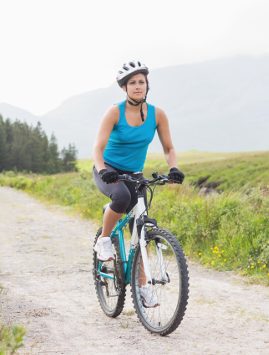Pedal power

Want to take up cycling but don’t know where to begin? Try these top expert tips.
Cycling is a fantastic way of improving your fitness levels. Practised regularly, it can help to build strength and muscle tone, improve your stamina, boost your cardiovascular fitness and improve your heart health. According to the British Cycling Federation, studies have shown that regular cyclists enjoy the general health of someone approximately 10 years younger! In addition, it is a low impact form of exercise, which means that it creates less stress on the joints, and it burns around 500 calories per hour when practised at a brisk pace.
They say you never forget how to ride a bike, but if you haven’t climbed into the saddle since childhood it’s a good idea to seek out some good advice and get the right equipment for you from the start. And this doesn’t necessarily mean having to spend a fortune. Find a local bike shop or cycling club and get some good advice based on experience and expertise from those in the know.
How to choose the right bike
It can be a bit daunting choosing a bike when there is so much choice and variety on offer. In order to narrow down the search a bit, you might want to consider having a bike fit. “This is approximately a two-hour session with a trained technician who will help to determine the optimum riding position for you to maximise comfort and performance and reduce risk of injury,” explains Morgan Lloyd, the physiotherapist and education manager with Cyclefit (www.cyclefit.co.uk).
After finding out your aims and goals, sporting background, training and past injury history, the fitter will carry out a physical evaluation to determine your physical conditioning through a series of measurements and observations. Then, while you ride to a special bike-fitting jig, a series of further measurements is taken until the optimal position is determined. After the session you will receive a list of options of bikes that will suit your riding style and allow for the correct position to be achieved.
Safety equipment
The importance of wearing a helmet shouldn’t be underestimated. “They will save your life – they’ve saved mine twice!” says Mike Sanderson, bike buyer for GO Outdoors and the designer of GO Outdoors’ own brand of bikes, Callibre (www.gooutdoors.co.uk). “It’s not just to protect you from being knocked off – your fall could be caused by any number of reasons; adverse conditions, lack of skill or, most embarrassing of all, falling at the traffic lights as you struggle to get ‘unclipped’. It’s also essential to choose clothing that is visible to other road users.
“Don’t underestimate how difficult it is sometimes for drivers to see a cyclist,” says Morgan. Padded shorts are another essential buy: “A good pair of cycling shorts worn without underwear coupled with the right saddle for you will mean more time in the saddle and less pain when you get back on the next time,” says Mike. “You don’t have to only wear the cycling shorts – baggy shorts or trousers can be worn over the top.” Lastly, make sure you purchase front and rear lights and consider using a rear light even in daylight hours.
Avoiding injuries
“Poor bike set-up or position is the main cause of cycling-related pain and injury,” says Morgan. “If you follow the fit-first philosophy then the bike should be set up to reflect your individual needs from the start, therefore reducing the risk of injury significantly. It’s not all about the bike, however. Maintaining good posture on the bike is key to reducing stress on the lower back and neck, even helping you to maximise performance. Maintaining good posture requires an awareness of just what is good cycling posture; don’t always look to the professional peloton for inspiration here! You need to understand the benefits behind it, a good bike position, good flexibility and core strength. These factors should all be evaluated and explained during a bike fit and the best fitters will be able to work with or refer you to a strength and conditioning coach or physio to help you improve in these areas if required.”
Bike maintenance
Your bike is a machine, it needs looking after,” says Mike. “Chains need regular cleaning/lubrication, brake pads need checking for wear and gears need a tweak from time to time. You can learn how to do these small things or get your local bike shop to do it for you. In the long run it will save you money and agro in the future. Punctures happen to the best of us so learn how to fix them – any bicycle mechanic will be pleased to show you – and make sure you have the basic kit needed to sort it out on the road. This includes a pump and a spare tube or a repair kit. It’s faster than the walk home!”
Keep at it!
“There isn’t a better time to take up the sport again,” says Morgan. “Bikes are more exciting than ever, technology is being used to enhance riding experience and cycling infrastructure is improving all the time.”
Mike adds: “Cycling is a truly wonderful way to travel and see the world. It’s low impact on your body’s joints and the benefits it will have to your health and wellbeing are well documented. Mostly importantly of all, it’s fun!”
Read previous Your Outdoor Living articles here...